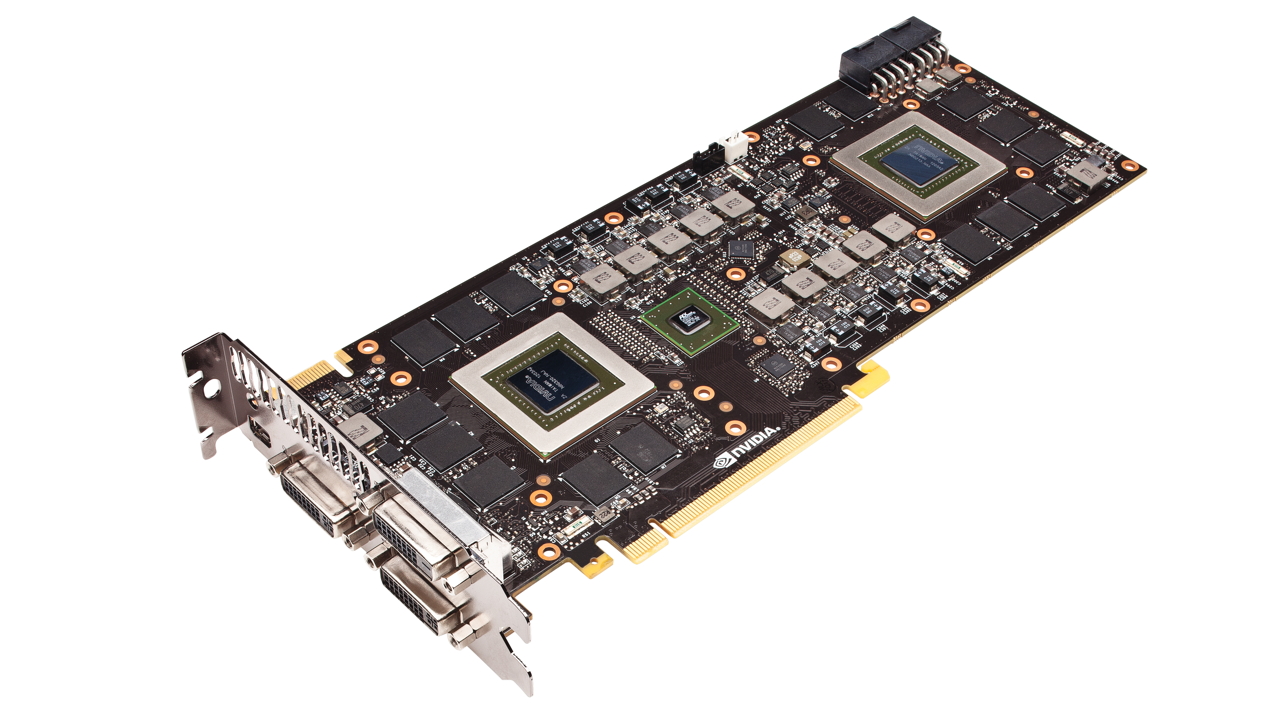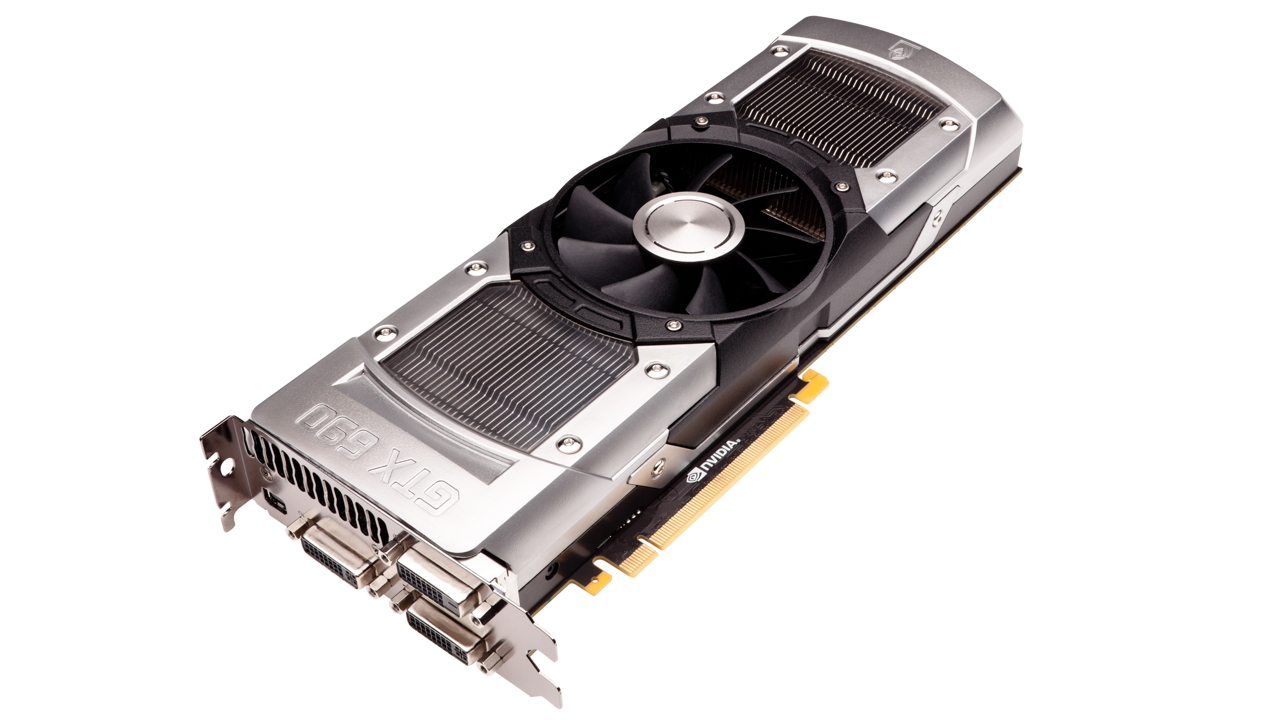TechRadar Verdict
The GTX 690 is a beautifully designed, and wonderfully engineered graphics card. Truly a thing of tech pornography. That said the performance it has on offer isn't anything wondrous compared to the cheaper GTX 670 SLI alternative.
Pros
- +
Excellent design
- +
Impressive performance
Cons
- -
Crazy-expensive
- -
Only slightly faster than GTX 670 SLI
Why you can trust TechRadar
The Nvidia GeForce GTX 690 has been hailed by the green graphics giant as 'the best graphics card that's ever been made.'
That's quite a claim, but bandying around phrases like 'trivalent chromium plating' and 'injection moulded magnesium alloy' in relation to its design means this expensive ol' graphics card bears serious inspection.
So yeah, before we get into all the tech pornography that is the Nvidia GTX 690 reference design - here showcased by EVGA - and it's technological make up, we do need to talk about that £830/$1000 price tag.
That's a huge amount of money to spend on any PC component, and granted, 90% of us would never even think of dropping that much money on a graphics card. But there are people out there with a penchant for the fastest whatever available and with the means to purchase them.
We've already covered the £1,400 Intel Xeon E5-2687W, the absolute pinnacle of CPU performance, and in relation the GTX 690 is actually rather cheap…
Okay, 'cheap' might be pushing it a little but you can see where we're going with this.
As the top fantasy graphics config we've been recommending the Nvidia GTX 680 in SLI configuration up to now, and that setup will cost you the same sort of price as a single GTX 690.
While that pairing is still faster there are significant advantages to just opting for a single graphics card – even one sporting two powerful GPUs – over the SLI configuration.
There's also the fact system integrators will be looking at the Nvidia GeForce GTX 690 with interest.
It will make things are lot easier in fashioning serious dream machines compared to setting up an SLI rig with hardcore cooling.
There has been consternation though about the GTX 680 not necessarily being the top-end Kepler GPU - more like the sort of architecture we were expecting lower down the Kepler tree – and yet still being priced at the top end.
While, as the fastest graphics card around, Nvidia has the right to price it in relation to the AMD competition, others have claimed it still has a responsibility to try and drive hardware adoption in the PC gaming sphere. Pricing the Kepler cards so high means that they are beyond the reach of most gamers.
Whatever the ethics, or the pricing structure of the graphics card market, there is still no getting away from the fact the Nvidia GeForce GTX 690 is one sexy bit of silicon wondrousness.
Vital stats
GPU
- 2x GK104
SMX modules
- 2x 8
CUDA cores
- 2x 1,536
Base clock
- 915MHz
Boost clock
- 1,019MHz
Memory
- 2x 4GB GDDR5
Architecture
So what is it that makes the Nvidia GeForce GTX 690 'the highest quality, most striking video card ever built?' Well, that's what Nvidia reckons, so what's it actually talking about?
Architecturally it's talking about a hybrid of the GK104 GPU, which powers both the GTX 680 and the Nvidia GTX 670, with two of those graphics chips crammed onto the same single slice of printed circuit board.
Why a hybrid?
Well, each of the GPUs in this EVGA GeForce GTX 690 contains the same number of CUDA cores that are in the GK104 in the GTX 680. That means we're looking at a total of 3,072 of those cores in the twin GPUs.

The two GK104 GPUs aren't running at GTX 680 speeds though, they are running at 915MHz instead; the same base clock as the new GTX 670 spin of the chip.
We're also looking at a huge 4GB of GDDR5 (two banks of 2GB) graphics memory sat around the two GPUs. That's running at the same 6Gbps speed as the memory on the GTX 680.
In order to keep these two chips chock full of juice there's a 10-phase power setup in between the two chips, with twin 8-pin PCIe power connectors taking the load from the PSU.
That gives the EVGA GTX 690 a relatively conservative 300w TDP. When you think both the previous generation dual-GPU cards - the Nvidia GTX 590 and the AMD Radeon HD 6990 - came with vast power requirements, hitting 365W and 375W respectively, that's rather efficient.
But the Nvidia GeForce GTX 690 isn't all about the internal architecture; the actual build of the card screams quality - and expense - from first glance.
The chassis of the card is built from riveted cast aluminium with that trivalent chromium plating. The chrome finish is then highly durable, but is more about aesthetics than anything else.
After all if your graphics card casing needs to be that durable you really need to question what you use it for.
The central fan housing is built from injection moulded magnesium alloy and if that sounds familiar you're probably a petrol-head as it's used in the construction of the beautiful Bugatti Veyron's engine.
Each of the GPUs in turn have their own separate cooling unit, using vapour chamber technology, around a centralised fan. Beneath that fan is a grooved plate to help direct airflow beneath the heat sinks and fins.
The result then is a well-cooled card, that still manages to remain relatively quiet during operation.
